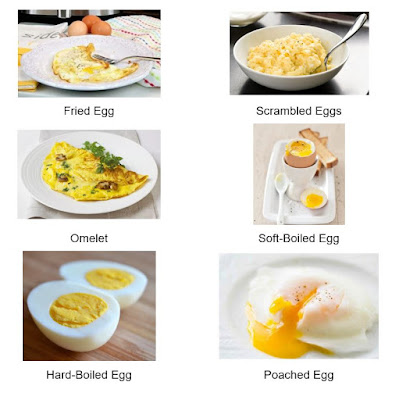Cooking Eggs
Types of
Cooked Eggs
By
Prof. Jonathan Acuña-Solano, M. Ed.
|
|
Head
of Curriculum Development
Academic
Department
Centro
Cultural Costarricense-Norteamericano
|
Senior Language Professor
School of English
Faculty
of Social Sciences
Universidad
Latina de Costa Rica
|
Tuesday, March 31, 2020
Post
343 / Vocabulary 005
|
|
Who hasn’t eaten an egg for breakfast?
Though most people may say they have eaten eggs for breakfast, we can venture
into exploring with our students the types of eggs they have tried for this morning
meal. On the other hand, we can also ask learners which type of cooked eggs
they like for breakfast or which ones they don’t like for it.
Here you are presented with six types
of cooked eggs that we can work with our students. We can ask them for their
preferences, but we can also venture in to asking them to go online and find
out how one specific type is prepared. These are just a couple of sample
activities for this topic.
Sample Activity 1 - Preferences
Provide your students with one of
these conversation cards. Have them work in pairs and as soon as their conversation
is over, move them to exchange information with another partner.
Student
A
|
Student
B
|
Ask your partner about what
he likes to eat for breakfast. Ask him/her for the kinds of eggs he/she likes
to eat for this morning meal. Also ask your partner for the kind of drink he/she
prefers to have for breakfast. And feel free to ask him/her any other
question you feel necessary.
|
Ask your partner about what
his/her parents like to eat for breakfast. Ask him/her for the kind of eggs
his/her parents like to eat for this morning meal. Also ask your partner for
the kind of drink his/her parents like to have for breakfast. And feel free
to ask additional questions if necessary.
|
Sample
Activity 2 - Recipes
A
second option is to have our learners continue productively speaking is to have
them search for simple recipes they can explain to the class. This is a very
good exercise to have students describe a process.
How
to Prepare _______________
First,
Second,
Next,
After that,
Finally,
|
Exercise
CEFR rage
|
A1
|
Bloom’s
Taxonomy layer
|
Analyze: organize, relate
Understand: describe, explain
|
References
Images
taken just for educational purposes from:
1) Fried
Egg https://www.kudoskitchenbyrenee.com/
2) Scrambled
Eggs https://www.delish.com/
3) Omelet
https://www.thespruceeats.com/
4) Soft-Boiled
Egg https://www.americastestkitchen.com/
5) Hard-Boiled
Egg https://nomnompaleo.com/
6) Poached
Eggs https://www.simplyrecipes.com/
7)
Bloom’s taxonomy https://twitter.com/profkhalid_ksa/status/1056576381751119872
Tuesday, March 31, 2020













